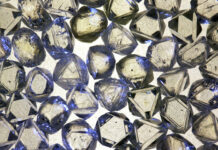[miningmx.com] — THE September quarterly reports of the three main gold mining groups – Gold Fields, AngloGold Ashanti and Harmony Gold – confirm why the share prices of all three are lower than a year ago.
This, at a time when more and more analysts are coming to the conclusion that the metal is in a long-term bull market and will crack the long-awaited $1,000/oz barrier in the not-too-distant future.
For the sad truth is that our mines find it well-nigh impossible to turn a higher metal price into higher profits. Of course, they can all offer good reasons for this.
AngloGold Ashanti has suffered from the overhang of the Anglo American shareholding and a gold hedge book that costs it more and more as the gold price firms; Harmony has had its well-publicised management problems; and Gold Fields is diverting current earnings to finance development of its South Deep project, which it believes will secure its long-term future, and pursue its international ambitions.
They can also point to specific short-term problems, while two of the three also have new bosses who, on historical precedent, can be expected to magnify the gravity of the situations they find themselves faced with. Plus there’s the greater emphasis on safety.
Unquestionably it’s desirable to keep mining fatalities to a minimum, but the fact is that deep-level mining is inherently a risky operation. Every life lost is a human tragedy, but when it comes to closing major shaft systems down for weeks one has to wonder whether emotion has outweighed proper cost-benefit analysis.
It may sound callous, but the harsh reality is that medical economists have devised formulae to determine whether the cost of (say) a liver transplant is justified against the economic wealth the recipient may generate in their expected extended life span.
Of course we must mourn every time an accident costs a miner’s life, and of course improved safety is essential; but we can’t go back to the days when every motor car on the roads had to be preceded by a man on horseback waving a red flag.
Harmony Gold
Turning more specifically to Harmony, the gold price received edged up from R151,400/kg in June to R156,200. Cash costs fell from R149,000 to R130,400/kg, and total costs from R152,700 to R133,500/kg.
That sounds pretty good, but remember that March and June figures were distorted by the notorious accounting problems – to which, strangely, there was no reference either in the web site presentation or the conference call I listened to – and the average cash cost for the six months to June was about R126,400/kg.
That’s still annual double-digit inflation, though we must remember that the September quarter for all groups bears the brunt of annual wage hikes, and this year from Eskom’s winter tariffs, as well.
And, while Harmony in spite of everything was able to report its first profit for some years in the year to June, the September quarter saw it back in a basic loss equivalent to 120c a share.
Acting CEO Graham Briggs says an internal due diligence survey of all assets has been completed and this quarter will see a strategic review of which are no longer economic – wrapped up by Briggs as a “restructuring of the portfolio”.
Analysts reckon half a dozen shafts could get the chop and already one, St Helena, is being run down, with workers being transferred to the nearby Phakisa project.
Harmony is also reviewing one of Briggs’ predecessor Bernard Swanepoel’s pet projects, conops – or continuing operations – which is apparently not producing the hoped-for benefits in the roughly half of Harmony’s mines in which it’s been introduced.
It’s investigating how to maximise value from its uranium reserves, with the implication that they may be up for sale, or at any rate a joint venture, and is looking for a 50% partner for its interests in Papua-New Guinea, specifically one who can bring expertise in copper mining and marketing to its Wafi/Golpu property.
While there’s been a four-month delay at Hidden Valley, because of late delivery of the SAG mill, this has its compensation, as it’s smoothing out a capex hump.
AngloGold Ashanti
If Harmony is undergoing major self-analysis, new AngloGold Ashanti CEO, Mark Cutifani, is doing much the same, but in a lower key.
Even after only a few weeks in the hot seat, he’s questioning a couple of traditional AngloGold shibboleths. “I’m not in principle enamoured of hedges,” he said, though he stressed that the AngloGold hedge must be run down in the most economic manner.
Considering that it’s now equivalent to roughly two years’ production, it’s not easy to see how this can be done. The hedge book’s negative marked-to-market value at September 30 was $3.5bn, up from $2.78bn three months earlier, and by October 31 it was up to $3.81bn. Because of the hedge, the gold price received for the quarter was 9% below spot.
For the September quarter the hedge, plus any other commodity contracts there may have been, converted a gross profit of R1.76bn into a R879m loss. The hedge decision will surely go down as the worst mistake made by Cutifani’s predecessors.
But even excluding the hedge costs, HEPS for the nine months to September fell from 2006’s 897c (SA) to 659c. Cash costs for the quarter rose 7%, from R75,700 to R81,200/kg, and total production costs 7.5%, from R99,700 to R107,200/kg.
Cutifani also presaged a review of AngloGold’s structure, saying it wants to be the most profitable, not the biggest, gold miner. He suggested five or six of its properties take more management attention that they’re worth.
Gold Fields
Gold Fields in a way had the least eventful quarter, though since quarter-end its asset sales have aroused much interest, as I wrote on October 12.
Total cash costs rose 7% from R92,000 to R99,200/kg owing to higher labour costs in South Africa and lower production at St Ives (Australia) and Tarkwa (West Africa).
CEO Ian Cockerill called this increase “unacceptably high”, but said recovering output at St Ives and Tarkwa should see a reversal of the trend “over the next few quarters” – which implies it could take a while.
Clearly, until South Deep ramps up its production, it’s just not possible to assess how a steady-state Gold Fields will shape.
It must be said that the September quarterlies were, across the board, disappointing. Maybe there was just an unfortunate coincidence of one-off setbacks, but costs remain an ongoing problem wherever you look.
Like the AngloGold hedge book, it’s not easy to see how this can be overcome – which is why the failure of conops to deliver is a big disappointment – but it may take some basic initiative here to make South African gold shares the favourite vehicle for international investors wanting to take part in the gold boom.











